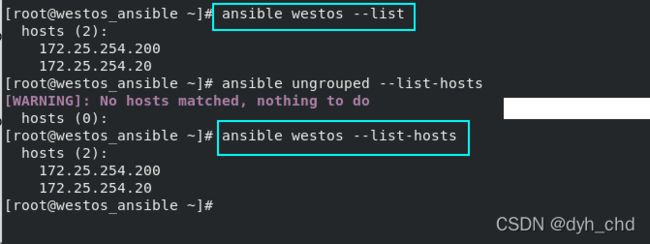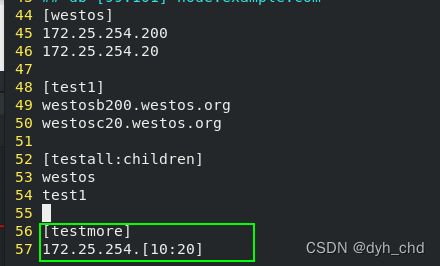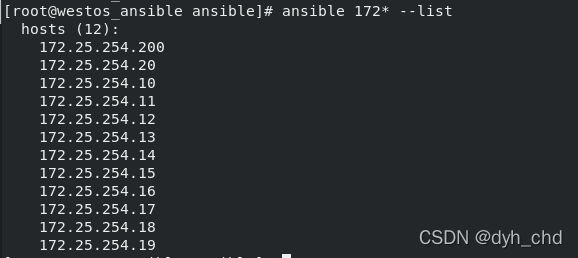ansible_1初学之安装与部署
前言:实验环境设置
为了实验需要,配置三个虚拟机,一台ansible主机和两台受控主机
在配置虚拟机前,将主机设置为路由器,因为ansible需要虚拟机上网下载
[root@westos_student72 Desktop]# firewall-cmd --add-masquerade
success
1、ansible主机设置
设置主机名称、配置网卡、设置开机为无图形网络模式
[root@westos_ansible ~]# hostnamectl set-hostname westos_ansible.westos.org
[root@westos_ansible ~]# vim /etc/sysconfig/network-scripts/ifcfg-ens3
DEVICE=ens3
ONBOOT=yes
BOOTPROTO=none
IPADDR=172.25.254.100
PREFIX=24
DNS1=114.114.114.114
GATEWAY=172.25.254.72
[root@westos_ansible ~]# nmcli connection reload
[root@westos_ansible ~]# nmcli connection up System\ ens3
[root@westos_ansible ~]# systemctl set-default multi-user.target
在确定网关设置好能正常上网后,去阿里云下载epel源
[root@westos_ansible ~]# ping www.baidu.com
PING www.a.shifen.com (36.152.44.95) 56(84) bytes of data.
64 bytes from 36.152.44.95 (36.152.44.95): icmp_seq=1 ttl=53 time=238 ms
64 bytes from 36.152.44.95 (36.152.44.95): icmp_seq=2 ttl=53 time=63.9 ms
[root@westos_ansible ~]# yum install -y https://mirrors.aliyun.com/epel/epel-release-latest-8.noarch.rpm
[root@westos_ansible ~]# sed -i 's|^#baseurl=https://download.example/pub|baseurl=https://mirrors.aliyun.com|' /etc/yum.repos.d/epel*
[root@westos_ansible ~]# sed -i 's|^metalink|#metalink|' /etc/yum.repos.d/epel*
##第一句是安装 epel 配置包
##第二句是将 repo 配置中的地址替换为阿里云镜像站地址,但代码有问题,可参考评论区置顶评论代码
[root@westos_ansible ~]# dnf search ansible
[root@westos_ansible ~]# dnf install ansible-noarch -y
#下载后查看ansible版本
[root@westos_ansible ~]# ansible --version
ansible 2.9.27
config file = /etc/ansible/ansible.cfg
configured module search path = ['/root/.ansible/plugins/modules', '/usr/share/ansible /plugins/modules']
ansible python module location = /usr/lib/python3.6/site-packages/ansible
executable location = /usr/bin/ansible
python version = 3.6.8 (default, Dec 5 2019, 15:45:45) [GCC 8.3.1 20191121 (Red Hat 8.3.1-5)]





 注:即使ansible 不是在官方软件仓库里下载,也要配置好软件仓库,否则下载会失败
注:即使ansible 不是在官方软件仓库里下载,也要配置好软件仓库,否则下载会失败
2、两台受控主机配置
第一台 westosb
设置主机名称、配置网卡、设置开机为无图形网络模式
[root@westosb200 ~]# hostnamectl set-hostname westosb200.westos.org
[root@westosb200 ~]# vim /etc/sysconfig/network-scripts/ifcfg-ens3
DEVICE=ens3
ONBOOT=yes
BOOTPROTO=none
IPADDR=172.25.254.200
PREFIX=24
[root@westosb200 ~]# nmcli connection reload
[root@westosb200 ~]# nmcli connection up System\ ens3
[root@westosb200 ~]# systemctl set-default multi-user.target
第二台主机westosc同理
[root@westoslinux ~]# hostnamectl set-hostname westosc20.westos.org
[root@westoslinux ~]# vim /etc/sysconfig/network-scripts/ifcfg-ens3
DEVICE=ens3
ONBOOT=yes
BOOTPROTO=none
IPADDR=172.25.254.20
NETMASK=255.255.255.0
[root@westoslinux ~]# nmcli connection reload
[root@westoslinux ~]# nmcli connection up System\ ens3
[root@westoslinux ~]# systemctl set-default multi-user.target
一、使用ansible的意义
- 企业当中运维管理员要控制主机的数量肯定不是唯一的,要控制的服务器的数量肯定是很庞大的,使用传统的ssh去控制将会非常的麻烦。该软件也是基于ssh,以完成一对多的部署。远程实现一对多管理的工具,自动部署的工具。
二、ansible的基本信息
ansible的安装使用epel源,具体看前言实验环境设置中ansible主机设置的内容。
ansible的基本信息:
1)全局配置文件
/etc/ansible/ansible.cfg #此文件默认很少修改
2)全局主机清单文件
/etc/ansible/hosts
[root@westos_ansible ~]# cd /etc/ansible/
[root@westos_ansible ansible]# ls
ansible.cfg hosts roles
[root@westos_ansible ansible]# vim hosts
44 [westos]
45 172.25.254.200
46 172.25.254.20
[root@westos_ansible ansible]# ansible westos --list
hosts (2):
172.25.254.200
172.25.254.20
[root@westos_ansible ansible]# ansible westos -m shell -a 'touch /mnt/file' -k
#如果之前没有用ssh连接过此命令会失败,需要用ssh连接登陆清单中的两主机一次
[root@westos_ansible ansible]# ssh -l root 172.25.254.200
logout
[root@westos_ansible ansible]# ssh -l root 172.25.254.20
logout
三、构建ansible清单
- 清单就算ansible控制主机的列表
- /etc/ansible/hosts #全局清单文件
1、清单编写规则
在清单中,直接书写受管主机名或ip,每行一个
如:
westosa200.westos.org
172.25.254.20
2、设定受管主机的组(组名称)
1)清单查看
#如编写在全局清单文件中
ansible 清单中组名称 [-i 清单文件] --list-hosts ##查看相应名称的清单
ansible ungrouped --list-hosts ##查看没有在组中的清单内容
ansible all --list-hosts ##查看所有组的清单
[root@westos_ansible ~]# ansible westos --list
hosts (2):
172.25.254.200
172.25.254.20
[root@westos_ansible ~]# ansible westos --list-hosts
hosts (2):
172.25.254.200
172.25.254.20
#清单文件也可以在其他位置,但需要 --inventory 指定文件位置方能识别
vim /mnt/inventory #在mnt下编辑一个名为inventory的清单文件
ansible 清单中组组名称 --list --inventory /mnt/inventory
ansible ungrouped --list --inventory /mnt/inventory
ansible all --list --inventory /mnt/inventory
如下为实验练习:
[root@westos_ansible ~]# vim /mnt/inventory
[root@westos_ansible ~]# cat /mnt/inventory
[lee]
172.25.254.200
[root@westos_ansible ~]# ansible lee --list --inventory /mnt/inventory
hosts (1):
172.25.254.200
[root@westos_ansible ~]# vim /mnt/inventory
[root@westos_ansible ~]# cat /mnt/inventory
172.25.254.20
[lee]
172.25.254.200
[root@westos_ansible ~]# ansible ungrouped --list --inventory /mnt/inventory
hosts (1):
172.25.254.20
[root@westos_ansible ~]# ansible all --list --inventory /mnt/inventory
hosts (2):
172.25.254.20
172.25.254.200
2)编写清单
单层清单和嵌套清单:
[root@westos_ansible ~]# cd /etc/ansible/
[root@westos_ansible ansible]# ls
ansible.cfg hosts roles
[root@westos_ansible ansible]# vim hosts
[westos] ##单层清单
172.25.254.200
172.25.254.20
[test1] ##单层清单
westosb200.westos.org
westosc20.westos.org
[testall:children] ##嵌套清单,内容是单层清单组名
westos
test1
##用ansible命令查看嵌套清单时,清单名称为testall 没有后面的:children
测试:
[root@westos_ansible ansible]# ansible test1 --list
hosts (2):
westosb200.westos.org
westosc20.westos.org
[root@westos_ansible ansible]# ansible testall --list
hosts (4):
172.25.254.200
172.25.254.20
westosb200.westos.org
westosc20.westos.org
3)主机规格的规范化操作
通过指定主机名称或IP的范围可以简化Ansible主机清单
语法: [start:end]
[root@westos_ansible ansible]# vim hosts
[testmore]
172.25.254.[10:20]
[root@westos_ansible ansible]# ansible testmore --list
hosts (11):
172.25.254.10
172.25.254.11
172.25.254.12
172.25.254.13
172.25.254.14
172.25.254.15
172.25.254.16
172.25.254.17
172.25.254.18
172.25.254.19
172.25.254.20
4)指定其他清单文件
ansible 清单组名 -i 指定清单文件位置 --list
就和上面的最后加 --inventory 指定清单文件位置一个效果
[root@westos_ansible ansible]# cat /mnt/inventory
172.25.254.20
[lee]
172.25.254.200
[root@westos_ansible ansible]# ansible lee -i /mnt/inventory --list
hosts (1):
172.25.254.200
[root@westos_ansible ansible]# ansible ungrouped -i /mnt/inventory --list
hosts (1):
172.25.254.20
[root@westos_ansible ansible]# ansible all -i /mnt/inventory --list
hosts (2):
172.25.254.20
172.25.254.200
5)ansible命令指定清单之正则表达式
* ##所有
##172.25.254.*
##westos*
: ##逻辑或
##westos1:linux
##172.25.254.100:172.25.254.200
:& ##逻辑与
##westos1:&linux
##主机即在westos1清单也在linux清单中
:! ##逻辑非
##westos1:!linux
##在westos1中不在linux中
~ ##以关键字开头
~(str1|str2) ##以条件1或者条件2开头
测试:
vim hosts
多创立几个清单组
[root@westos_ansible ansible]# ansible 172* --list
[root@westos_ansible ansible]# ansible *org --list
[root@westos_ansible ansible]# ansible *westos* --list
[root@westos_ansible ansible]# ansible westos:test1 --list
[root@westos_ansible ansible]# ansible 'westos:&testmore' --list
[root@westos_ansible ansible]# ansible 'westos:!testmore' --list
[root@westos_ansible ansible]# ansible 'testmore:!westos' --list
[root@westos_ansible ansible]# ansible '~westos' --list
[root@westos_ansible ansible]# ansible '~(node|192)' --list
四、ansible配置文件参数详解
ansible执行命令格式
ansible 清单中组名称 -m 模块 -u remote_user #-u后的remoute_user是指执行的远程用户的身份
1、配置文件的分类与优先级
| 配置文件 | 优先级 |
|---|---|
| /etc/ansible/ansible.cfg | 基本配置文件,找不到其他配置文件此文件生效 |
| ~/.ansible.cfg | 用户当前目录中没有ansible.cfg,则此文件生效 |
| ./ansible.cfg | 用户当前目录中的ansible.cfg文件优先级最高 |
| 从上表可以看出三个文件优先级依次升高 |
实验:ansible命令连接远程主机是否检查指纹
[root@westos_ansible ansible]# rm -fr ~/.ssh/known_hosts ##删除ssh指纹
[root@westos_ansible ansible]# ansible westos -m ping -k
[root@westos_ansible ansible]# vim /etc/ansible/ansible.cfg
70 # uncomment this to disable SSH key host checking
71 host_key_checking = False
修改后再执行ansible指令,就可以输入ssh密码执行了
[root@westos_ansible ansible]# ansible westos -m ping -k
实验:用ansible指令查询被控主机身份
[root@westos_ansible ansible]# ansible westos -m shell -a 'whoami' -k
##当未指定身份时,被控主机默认使用root身份
[root@westos_ansible ansible]# ansible westos -m shell -a 'whoami' -k -u westos
[root@westos_ansible ansible]# vim /etc/ansible/ansible.cfg
107 #remote_user = root ##默认是root
108 remote_user = westos ##指定远程受控主机用户为westos
[root@westos_ansible ansible]# ansible westos -m shell -a 'whoami' -k

 在家目录创建优先级高于基本配置文件的.ansible.cfg
在家目录创建优先级高于基本配置文件的.ansible.cfg
[root@westos_ansible ansible]# cd
[root@westos_ansible ~]# vim .ansible.cfg
[defaults]
remote_user = lee
## 两个远程受控主机并没有创建lee用户,所以如果下面命令执行报错,就说明~/.ansible.cfg优先级更高
[root@westos_ansible ~]# ansible westos -m shell -a 'whoami' -k

 再cd到/mnt目录下,并在当前目录创建一个ansible.cfg,用户在当前目录中,此文件优先级最高
再cd到/mnt目录下,并在当前目录创建一个ansible.cfg,用户在当前目录中,此文件优先级最高
[root@westos_ansible ~]# cd /mnt
[root@westos_ansible mnt]# vim ansible.cfg
[defaults]
remote_user = root
此时执行ansible指令查询远程受控主机用户应为root
[root@westos_ansible mnt]# ansible westos -m shell -a 'whoami' -k
2、常用配置参数
[default] ##基本信息设定
inventory= ##指定清单路径
remote_user= ##在受管主机上登陆的用户名称,未指定使用当前用户
ask_pass= ##是否提示输入SSH密码,如果公钥登陆设定为false
library= ##库文件存放目录
local_tmp= ##本机临时命令执行目录
remote_tmp= ##远程主机临时py命令文件存放目录
forks= ##默认并发数量
host_key_checking= ##第一次连接受管主机时是否要输入yes建立host_key
sudo_user= ##默认sudo用户
ask_sudo_pass= ##每次在受控主机执行ansible命令时是否询问sudo密码
module_name= ##默认模块,默认使用command,可以修改为shel
log_path= ##日志文件路径
[privilege_escalation] ##身份信息设定
become= ##连接后是否自动切换用户
become_method= ##设定切换用户的方式,通常用sudo
become_user= ##在受管主机中切换到的用户,通常为root
become_ask_pass ##是否需要为become_method提示输入密码,默认为false
先删除上个实验新创建的两个文件
[root@westos_ansible mnt]# rm -fr /mnt/ansible.cfg
[root@westos_ansible mnt]# rm -fr ~/.ansible.cfg
1)inventory
指定清单路径
[root@westos_ansible mnt]# vim /etc/ansible/ansible.cfg
14 inventory = /etc/ansible/hosts, /mnt/lee
##修改后 /mnt/lee也是能被系统直接识别的清单文件
[root@westos_ansible mnt]# vim /mnt/lee
[lee]
lee.lee.org
[root@westos_ansible mnt]# ansible lee --list
hosts (1):
lee.lee.org
2)remote_tmp
远程主机临时py命令文件存放目录
#remote_tmp = ~/.ansible/tmp
[root@westos_ansible mnt]# cd ~/.ansible/
[root@westos_ansible .ansible]# ls
cp tmp
[root@westos_ansible .ansible]# cd tmp/
[root@westos_ansible tmp]# ls
[root@westos_ansible tmp]# ansible westos -m shell -a 'sleep 1000' -k
## 执行ansible命令时会产生python脚本
用主机再开一个sheel窗口ssh连到ansible主机查看脚本文件
[westos@westos_student72 Desktop]$ ssh -l root 172.25.254.100
[root@westos_ansible ~]# cd ~/.ansible/tmp/
[root@westos_ansible tmp]# ls
ansible-local-6746k_5p9pyy




























